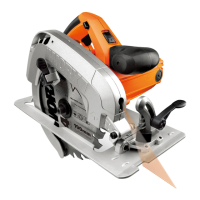Circular saw with laser EN
7
operating cycle such as the times when the tool
is switched off and when it is running idle but not
actually doing the job. This may significantly
reduce the exposure level over the total working
period.
Helping to minimise your vibration exposure risk.
ALWAYS use sharp chisels, drills and blades
Maintain this tool in accordance with these instructions
and keep well lubricated (where appropriate)
If the tool is to be used regularly then invest in anti
vibration accessories.
Avoid using tools in temperatures of 10
0
C or less
Plan your work schedule to spread any high vibration
tool use across a number of days.
ACCESSORIES
Vacuum adaptor 1
Parallel guide 1
Hex key 1
Blade: 190mmx30mmx24T (only for WX445) 1
Blade: 185mmx16mmx24T (only for WX445.1)
2
We recommend that you purchase your accessories
from the same store that sold you the tool. Refer to
the accessory packaging for further details. Store
personnel can assist you and offer advice.
SAFETY WARNINGS FOR
ALL SAWS
a) DANGER: Keep hands away from
cutting area and the blade. Keep your
second hand on auxiliary handle, or
motor housing. If both hands are holding the
saw, they cannot be cut by the blade.
b) Do not reach underneath the workpiece. The
guard cannot protect you from the blade below
the workpiece.
c) Adjust the cutting depth to the thickness
of the workpiece. Less than a full tooth of
the blade teeth should be visible below the
workpiece.
d) Never hold piece being cut in your hands or
across your leg. Secure the workpiece to a
stable platform. It is important to support the
work properly to minimize body exposure, blade
binding, or loss of control.
e) Hold the power tool by insulated gripping
surfaces only, when performing an
operation where the cutting tool may
contact hidden wiring or its own cord.
Contact with a “live” wire will also make exposed
metal parts of the power tool “live” and could
give the operator an electric shock.
f) When ripping always use a rip fence or
straight edge guide. This improves the accuracy
of cut and reduces the chance of blade binding.
g) Always use blades with correct size and
shape (diamond versus round) of arbour
holes. Blades that do not match the mounting
hardware of the saw will run eccentrically,
causing loss of control.
h) Never use damaged or incorrect blade
washers or bolt. The blade washers and
bolt were specially designed for your saw, for
optimum performance and safety of operation.
FURTHER SAFETY
INSTRUCTIONS FOR ALL
SAWS
KICKBACK CAUSES AND RELATED WARNINGS
- kickback is a sudden reaction to a pinched, bound
or misaligned saw blade, causing an uncontrolled
saw to lift up and out of the workpiece toward the
operator;
- when the blade is pinched or bound tightly by the
kerf closing down, the blade stalls and the motor
reaction drives the unit rapidly back toward the
operator;
- if the blade becomes twisted or misaligned in the
cut, the teeth at the back edge of the blade can dig
into the top surface of the wood causing the blade
to climb out of the kerf and jump back toward the
operator.
Kickback is the result of saw misuse and/or incorrect
operating procedures or conditions and can be
avoided by taking proper precautions as given below.
a) Maintain a firm grip with both hands on
the saw and position your arms to resist
kickback forces. Position your body to
either side of the blade, but not in line with
the blade. Kickback could cause the saw to jump
backwards, but kickback forces can be controlled
by the operator, if proper precautions are taken.
b) When blade is binding, or when interrupting
a cut for any reason, release the trigger and
hold the saw motionless in the material until
the blade comes to a complete stop. Never
attempt to remove the saw from the work
or pull the saw backward while the blade is
in motion or kickback may occur. Investigate
and take corrective actions to eliminate the cause
of blade binding.
c) When restarting a saw in the workpiece,
centre the saw blade in the kerf and check
that saw teeth are not engaged into the
material. If saw blade is binding, it may walk
up or kickback from the workpiece as the saw is
restarted.
d)
Support large panels to minimise the risk
of blade pinching and kickback. Large panels
tend to sag under their own weight. Supports
must be placed under the panel on both sides,
near the line of cut and near the edge of the panel.
e) Do not use dull or damaged blades.
Unsharpened or improperly set blades produce
narrow kerf causing excessive friction, blade
binding and kickback.

